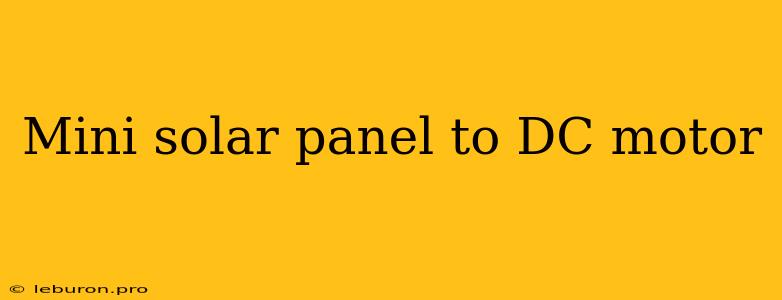Harnessing the power of the sun to drive a DC motor is a fascinating and practical project that can be achieved with a mini solar panel. This project is ideal for educational purposes, introducing fundamental concepts of renewable energy and electrical circuits to students of all ages. The simplicity of the design and the readily available materials make it an engaging and rewarding experience. This article delves into the intricacies of this project, explaining the essential components, outlining the construction process, and exploring the various applications of this mini solar panel-powered DC motor system.
Understanding the Components:
The Mini Solar Panel:
A mini solar panel is a crucial component of this system, responsible for converting sunlight into electrical energy. This conversion process, known as the photovoltaic effect, occurs within the solar panel's silicon cells. When sunlight strikes the panel, photons, or energy packets, knock electrons loose from their atoms. These free electrons then flow through an electrical circuit, creating a direct current (DC). The size and efficiency of the mini solar panel determine the amount of electrical power it can generate, impacting the motor's speed and torque. For this project, a small solar panel with an output voltage of 1.5 to 6 volts is suitable.
The DC Motor:
The DC motor is the heart of this system, converting the electrical energy generated by the mini solar panel into mechanical energy. A DC motor operates by the interaction of a magnetic field produced by the motor's electromagnet with the magnetic field of permanent magnets. The flow of electricity through the motor's armature, a rotating shaft, creates torque, resulting in the motor's rotation. The motor's speed and torque are influenced by the voltage supplied by the solar panel and the motor's internal resistance. For this project, a small DC motor with a voltage rating matching the solar panel's output is preferred.
Building the Mini Solar Panel to DC Motor System:
The construction of this system involves connecting the mini solar panel to the DC motor through a simple electrical circuit. Here's a step-by-step guide:
-
Materials:
- Mini solar panel
- DC motor
- Wires (with alligator clips or soldering iron)
- Switch (optional)
- Breadboard (optional)
-
Circuit Setup:
- Connect the positive terminal (usually marked "+") of the mini solar panel to the positive terminal of the DC motor using a wire.
- Connect the negative terminal (usually marked "-") of the mini solar panel to the negative terminal of the DC motor using another wire.
- If using a switch, connect it in series with the circuit, interrupting the flow of electricity to the motor.
- If using a breadboard, connect the components to the appropriate terminals on the breadboard for easier wiring and testing.
-
Testing:
- Expose the mini solar panel to direct sunlight.
- Observe the DC motor's rotation. The speed of the motor will be proportional to the intensity of sunlight hitting the panel.
- If using a switch, test the on and off functionality.
Applications and Potential Enhancements:
The mini solar panel to DC motor system has numerous applications, ranging from simple educational demonstrations to more complex projects:
Educational Demonstrations:
- Renewable Energy Introduction: Demonstrating the basics of solar energy conversion and its use to power a motor.
- Electrical Circuit Basics: Exploring the concepts of circuits, current flow, and voltage in a practical setting.
- Science Fair Projects: Designing creative projects that incorporate solar power and DC motor operation.
Practical Applications:
- Small-scale Robotics: Utilizing the system to power simple robots, like solar-powered car models.
- Solar-powered Toys: Integrating the system into toys, adding a sustainable and interactive element.
- Fan or Pump Applications: Connecting a small fan or pump to the motor for ventilation or water movement.
Potential Enhancements:
- Adding a Gearbox: Using a gearbox to increase the motor's torque, allowing it to power heavier loads or operate at slower speeds.
- Integrating Sensors: Implementing light sensors to automatically turn the motor on or off based on sunlight intensity.
- Battery Storage: Incorporating a rechargeable battery to store excess solar energy, allowing the motor to operate even in low-light conditions.
Conclusion:
The mini solar panel to DC motor system is a remarkable example of how readily available materials can be used to explore the fascinating world of renewable energy. From educational demonstrations to practical applications, this project offers a unique opportunity to understand the fundamentals of electricity, magnetism, and solar power conversion. As you delve deeper into this project, consider the numerous potential enhancements that can further expand its capabilities and applications. The endless possibilities of this simple yet powerful system make it a valuable tool for learning, innovation, and sustainable development.
